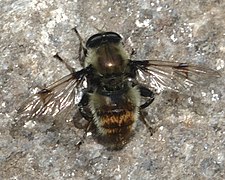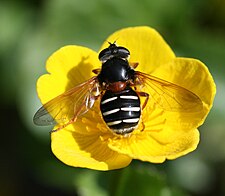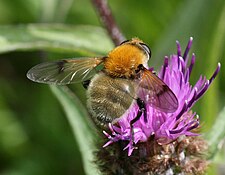Sericomyia: Difference between revisions
added a synonym |
I Am Andumé (talk | contribs) removed Category:Eristalinae; added Category:Sericomyiini using HotCat Tags: Mobile edit Mobile web edit Advanced mobile edit |
||
| (16 intermediate revisions by 11 users not shown) | |||
| Line 1: | Line 1: | ||
{{Short description|Genus of flies}} |
|||
{{italic title}}{{Taxobox |
|||
{{Automatic taxobox |
|||
| name = ''Sericomyia'' |
|||
| image = Seriomia silentis1.jpg |
| image = Seriomia silentis1.jpg |
||
| image_caption = |
| image_caption = Male ''[[Sericomyia silentis]]'' |
||
| |
| taxon = Sericomyia |
||
| ⚫ | |||
| phylum = [[Arthropod]]a |
|||
| classis = [[Insect]]a |
|||
| ordo = [[Fly|Diptera]] |
|||
| familia = [[Hoverfly|Syrphidae]] |
|||
| subfamilia = [[Eristalinae]] |
|||
| tribus = [[Sericomyiini]] |
|||
| genus = '''''Sericomyia''''' |
|||
| ⚫ | |||
| type_species = |
| type_species = |
||
| type_species_authority = |
| type_species_authority = |
||
| Line 18: | Line 11: | ||
*''Sericomyza'' <small>[[Johan Wilhelm Zetterstedt|Zetterstedt]], 1838</small> |
*''Sericomyza'' <small>[[Johan Wilhelm Zetterstedt|Zetterstedt]], 1838</small> |
||
}} |
}} |
||
| ⚫ | |||
Sercomyia are large flies with species that are bee mimics both short pile and long pile. |
|||
Sericomyiine flower flies are common in [[boreal forests]] across the [[Holarctic]] region and southward at higher elevations into the [[Oriental]] and [[Neotropical]] regions.<ref name=gbif> {{Cite web| title=''Sercomyia ''| url=https://www.gbif.org/species/1538780| website=GBIF| accessdate=2020-07-28}}</ref> |
|||
Sericomyia species have larvae of the [[rat-tailed maggot]] type, often found in ponds rich in decomposing vegetation where they filter out microorganisms as their |
|||
| ⚫ | food <ref > {{cite journal |last=Rotheray |first=G.E. |year=1993 |title= Colour Guide to Hoverfly Larvae (Diptera, Syrphidae) in Britain and Europe |journal=Diperists Digest |volume=9 |pages=155 |url= https://diptera.info/downloads/df_1_9_Colour_Guide_to%20Hoverfly_Larvae.pdf }} </ref><ref name="VanVeen">{{cite book |last= Van Veen |first= M.P. |title= Hoverflies of Northwest Europe, Identification Keys to the Syrphidae |type= Hardback |year= 2004 |publisher= KNNV Publishing |location= Utrecht |isbn= 90-5011-199-8 |pages= 254 }}</ref><ref>{{cite book|author1=Stubbs, Alan E. |author2=Falk, Steven J. |name-list-style=amp |year=1983 |title=British Hoverflies: An Illustrated Identification Guide |publisher=British Entomological & Natural History Society|page=253, xvpp}}</ref> |
||
==Description== |
|||
[[file:Sericomyia chalcopyga head.png| thumb|Sericomyia head, plumose arista]] |
|||
They have an oval flagellum with a plumose arista. The eye are bare and narrowly to |
|||
broadly [[holoptic]] in male. The wings are darkly colored along the anterior margin. |
|||
Cell r1 is open. The stigmatic crossvein is absent. The cell |
|||
r<sub>4+5</sub> with long petiole, longer than humeral crossvein. |
|||
The vein <sub>R4+5</sub> is straight to moderately sinuate.<ref>{{Cite journal | title = Review of New World Sericomyia (Diptera: Syrphidae), including description of a new species | date = 2012 | last1 = Skevington | first1 = J. H. | last2 = Thompson | first2 = F. C. | journal = The Canadian Entomologist | volume = 144| issue = 2| pages = 216–247 | url =http://www.canacoll.org/Diptera/Staff/Skevington/pdfs/Skevington_Sericomyia_high_resolution.pdf | doi = 10.4039/tce.2012.24 }}</ref> |
|||
[[file:Sericomyia diagram wing.png|thumb| Sericomyia wing diagram]] |
|||
[[file:Sericomyia chalcopyga head.png| thumb|Sericomyia head, plumose arista]] |
|||
==Species== |
==Species== |
||
{{col-begin|width=auto}} |
{{col-begin|width=auto}} |
||
{{col-break}} |
{{col-break}} |
||
'''Subgenus:''' ''Sericomyia'' |
'''Subgenus:''' ''[[Sericomyia (subgenus)|Sericomyia]]'' |
||
*''[[Sericomyia arctica]]'' <small>Schirmer, 1913</small> |
*''[[Sericomyia arctica|S. arctica]]'' <small>Schirmer, 1913</small> |
||
*''[[Sericomyia bifasciata|S. bifasciata]]'' <small>[[Samuel Wendell Williston|Williston]], 1887</small><ref >{{cite journal |last1=Williston |first1=S.W. |title=Synopsis of the North American Syrphidae |journal=Bulletin of the United States National Museum |date=1887 |volume=31 |pages=1–335 |url=https://books.google.com/books?id=7i4oAAAAYAAJ}}</ref> |
|||
| ⚫ | |||
*''[[Sericomyia carolinensis]]'' <small>(Metcalf, 1917)</small> |
*''[[Sericomyia carolinensis|S. carolinensis]]'' <small>(Metcalf, 1917)</small> |
||
*''[[Sericomyia chalcopyga]]'' <small>[[Hermann Loew|Loew]], 1863</small> |
*''[[Sericomyia chalcopyga|S. chalcopyga]]'' <small>[[Hermann Loew|Loew]], 1863</small> |
||
*''[[Sericomyia chrysotoxoides]]'' <small>[[Justin |
*''[[Sericomyia chrysotoxoides|S. chrysotoxoides]]'' <small>[[Pierre-Justin-Marie Macquart|Macquart]], 1842</small> |
||
*''[[Sericomyia dux]]'' <small>(Stackelberg, 1930)</small><ref name="szmn">{{cite web |first = A.V |last = Barkalov |title = Syrphidae collection of Siberian Zoological Museum |url = http://szmn.sbras.ru/Diptera/Syrphidae.htm |publisher = the Institute of Animal Systematics and Ecology, Siberian Branch of the Russian Academy of Sciences |location = Novosibirsk, Russia | |
*''[[Sericomyia dux|S. dux]]'' <small>([[Aleksandr Stackelberg|Stackelberg]], 1930)</small><ref name="szmn">{{cite web |first = A.V |last = Barkalov |title = Syrphidae collection of Siberian Zoological Museum |url = http://szmn.sbras.ru/Diptera/Syrphidae.htm |publisher = the Institute of Animal Systematics and Ecology, Siberian Branch of the Russian Academy of Sciences |location = Novosibirsk, Russia |access-date = 17 August 2009 |archiveurl=https://web.archive.org/web/20081020082104/http://szmn.sbras.ru/Diptera/Syrphidae.htm |archivedate=October 20, 2008}}</ref> |
||
*''[[Sericomyia hispanica]]'' <small>Peris Torres, 1962</small> |
*''[[Sericomyia hispanica|S. hispanica]]'' <small>Peris Torres, 1962</small> |
||
*''[[Sericomyia jakutica]]'' <small>(Stackelberg, 1927)</small> |
*''[[Sericomyia jakutica|S. jakutica]]'' <small>([[Aleksandr Stackelberg|Stackelberg]], 1927)</small> |
||
*''[[Sericomyia lappona]]'' <small>([[ |
*''[[Sericomyia lappona|S. lappona]]'' <small>([[Carl Linnaeus|Linnaeus]], [[10th edition of Systema Naturae|1758]])</small> |
||
*''[[Sericomyia lata]]'' <small>([[Daniel William Coquillett|Coquillett]], 1907)</small> |
*''[[Sericomyia lata|S. lata]]'' <small>([[Daniel William Coquillett|Coquillett]], 1907)</small><ref > |
||
{{cite journal |
|||
| ⚫ | |||
|last=Coquillett |
|||
| ⚫ | |||
|first=D.W. |
|||
| ⚫ | |||
|year=1907 |
|||
| ⚫ | |||
|title=NEW GENERA AND SPECIES OF DIPTERA |
|||
| ⚫ | |||
|journal=The Canadian Entomologist |
|||
*''[[Sericomyia slossonae]]'' <small>[[Charles Howard Curran|Curran]], 1934</small> |
|||
|volume=39 |
|||
*''[[Sericomyia transversa]]'' <small>(Osburn, 1926)</small> |
|||
|issue=3 |
|||
|pages=75–76 |
|||
|doi=10.4039/Ent3975-3 |
|||
|url=https://www.biodiversitylibrary.org/page/27847977#page/89/mode/1up |
|||
}} |
|||
</ref> |
|||
| ⚫ | |||
| ⚫ | |||
| ⚫ | |||
| ⚫ | |||
| ⚫ | |||
| ⚫ | |||
{{cite journal |
|||
|last=Curran |
|||
|first=Charles Howard |
|||
|year= 1934 |
|||
|title=Notes on the Syrphidae in the Slosson Collection of Diptera. |
|||
|journal=Amer. Mus. Nat. Hist., Amer. Mus. Novitates |
|||
|volume=724 |
|||
|pages= 1–7 |
|||
|url=https://digitallibrary.amnh.org/bitstream/handle/2246/2099//v2/dspace/ingest/pdfSource/nov/N0724.pdf?sequence=1&isAllowed=y |
|||
}} |
|||
</ref> |
|||
*''[[Sericomyia transversa|S. transversa]]'' <small>(Osburn, 1926)</small><ref > {{cite journal |last=Osburn |first=Raymond |year=1926 |title=A New Species of the Genus Condidea |journal= Entomological News |volume=37 |pages= 51 |url=https://www.biodiversitylibrary.org/page/2655293#page/71/mode/1up}} </ref> |
|||
{{col-break}} |
{{col-break}} |
||
'''Subgenus:''' ''[[Arctophila (fly)|Arctophila]]'' |
'''Subgenus:''' ''[[Arctophila (fly)|Arctophila]]'' |
||
*''[[Sericomyia bequaerti]]'' <small>(Hervé-Bazin, 1913)</small> |
*''[[Sericomyia bequaerti|S. bequaerti]]'' <small>(Hervé-Bazin, 1913)</small> |
||
*''[[Sericomyia bombiformis]]'' <small>([[Carl Fredrik Fallén|Fallén]], 1810)</small> |
*''[[Sericomyia bombiformis|S. bombiformis]]'' <small>([[Carl Fredrik Fallén|Fallén]], 1810)</small> |
||
*''[[Sericomyia flagrans]]'' <small>([[ |
*''[[Sericomyia flagrans|S. flagrans]]'' <small>([[Carl Robert Osten-Sacken|Osten Sacken]], 1875)</small> |
||
*''[[Sericomyia harveyi]]'' <small>(Osburn, 1908)</small> |
*''[[Sericomyia harveyi|S. harveyi]]'' <small>(Osburn, 1908)</small> |
||
*''[[Sericomyia meyeri]]'' <small>(Fluke, 1939)</small> |
*''[[Sericomyia meyeri|S. meyeri]]'' <small>(Fluke, 1939)</small> |
||
*''[[Sericomyia superbiens]]'' <small>( |
*''[[Sericomyia superbiens|S. superbiens]]'' <small>(Müller, 1776)</small> |
||
{{col-break}} |
{{col-break}} |
||
'''Subgenus:''' ''Conosyrphus'' |
'''Subgenus:''' ''[[Conosyrphus]]'' |
||
*''[[Sericomyia tolli]]'' <small>([[ |
*''[[Sericomyia tolli|S. tolli]]'' <small>([[Richard Karl Hjalmar Frey|Frey]], 1915)</small> |
||
{{col-end}} |
{{col-end}} |
||
| Line 69: | Line 100: | ||
==References== |
==References== |
||
{{ |
{{Reflist}} |
||
{{Taxonbar|from=Q2075839}} |
|||
[[Category:Diptera of Europe]] |
[[Category:Diptera of Europe]] |
||
| Line 75: | Line 108: | ||
[[Category:Diptera of North America]] |
[[Category:Diptera of North America]] |
||
[[Category:Hoverfly genera]] |
[[Category:Hoverfly genera]] |
||
[[Category: |
[[Category:Sericomyiini]] |
||
[[Category:Taxa named by Johann Wilhelm Meigen]] |
[[Category:Taxa named by Johann Wilhelm Meigen]] |
||
Latest revision as of 05:11, 11 October 2023
| Sericomyia | |
|---|---|

| |
| Male Sericomyia silentis | |
| Scientific classification | |
| Domain: | Eukaryota |
| Kingdom: | Animalia |
| Phylum: | Arthropoda |
| Class: | Insecta |
| Order: | Diptera |
| Family: | Syrphidae |
| Genus: | Sericomyia Meigen, 1803 |
| Synonyms | |
| |
Sercomyia are large flies with species that are bee mimics both short pile and long pile. Sericomyiine flower flies are common in boreal forests across the Holarctic region and southward at higher elevations into the Oriental and Neotropical regions.[1] Sericomyia species have larvae of the rat-tailed maggot type, often found in ponds rich in decomposing vegetation where they filter out microorganisms as their food [2][3][4]
Description[edit]

They have an oval flagellum with a plumose arista. The eye are bare and narrowly to broadly holoptic in male. The wings are darkly colored along the anterior margin. Cell r1 is open. The stigmatic crossvein is absent. The cell r4+5 with long petiole, longer than humeral crossvein. The vein R4+5 is straight to moderately sinuate.[5]


Species[edit]
|
Subgenus: Sericomyia
|
Subgenus: Arctophila
|
Subgenus: Conosyrphus
|
Gallery[edit]
-
Sericomyia chrysotoxoides female
-
Sericomyia flagrans male
-
Sericomyia lappona female
-
Sericomyia militaris female
-
Sericomyia silentis female
-
Sericomyia superbiens female
References[edit]
- ^ "Sercomyia ". GBIF. Retrieved 2020-07-28.
- ^ Rotheray, G.E. (1993). "Colour Guide to Hoverfly Larvae (Diptera, Syrphidae) in Britain and Europe" (PDF). Diperists Digest. 9: 155.
- ^ Van Veen, M.P. (2004). Hoverflies of Northwest Europe, Identification Keys to the Syrphidae (Hardback). Utrecht: KNNV Publishing. p. 254. ISBN 90-5011-199-8.
- ^ Stubbs, Alan E. & Falk, Steven J. (1983). British Hoverflies: An Illustrated Identification Guide. British Entomological & Natural History Society. p. 253, xvpp.
- ^ Skevington, J. H.; Thompson, F. C. (2012). "Review of New World Sericomyia (Diptera: Syrphidae), including description of a new species" (PDF). The Canadian Entomologist. 144 (2): 216–247. doi:10.4039/tce.2012.24.
- ^ Williston, S.W. (1887). "Synopsis of the North American Syrphidae". Bulletin of the United States National Museum. 31: 1–335.
- ^ a b Barkalov, A.V. "Syrphidae collection of Siberian Zoological Museum". Novosibirsk, Russia: the Institute of Animal Systematics and Ecology, Siberian Branch of the Russian Academy of Sciences. Archived from the original on October 20, 2008. Retrieved 17 August 2009.
- ^ Coquillett, D.W. (1907). "NEW GENERA AND SPECIES OF DIPTERA". The Canadian Entomologist. 39 (3): 75–76. doi:10.4039/Ent3975-3.
- ^ Curran, Charles Howard (1934). "Notes on the Syrphidae in the Slosson Collection of Diptera" (PDF). Amer. Mus. Nat. Hist., Amer. Mus. Novitates. 724: 1–7.
- ^ Osburn, Raymond (1926). "A New Species of the Genus Condidea". Entomological News. 37: 51.






